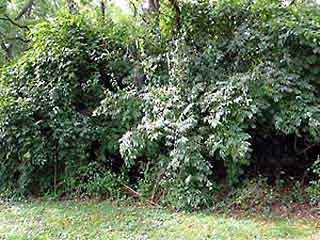 |
My woods looked like this when I started my woodland project in 2002. Honeysuckle invaded in the 1960s and choked all other plants out, except for garlic-mustard. It had a lovely flower and provided cover for the birds. But it also wiped out the ephemeral wildflowers, except for toothworth and a small patch of Virginia bluebells by the patio. We had more than 400 honeysuckles of various sizes removed. The garlic-mustard came on so fast that it was a threat to the entire woods. I pulled the garlic-mustard out by hand. It took me three years to clean out these pests and get flowers blooming profusely again in the woods.
|
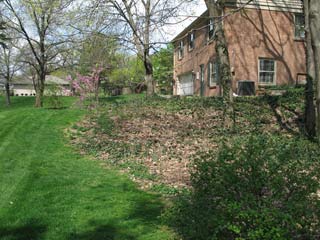 |
The pink in the upper left of the photo is a small grove of redbud trees that were bareroot when I planted them. They flowered for the first time this year. Three are covered with blossoms and two smaller ones have a cluster or two. Purple violets, sweet woodruff and a few May-apples cover the ground around them. Picture this same hillside covered with honeysuckle. The biggest one was over twelve feet tall and had a trunk more than a foot in diameter.
|
 |
These redbud trees were single twigs when I put them in the ground in 2002. There were 9 to begin with. Three have grown well and are in full bloom. Two more had a few blossoms, like these did last year. The others are still quite small and haven't bloomed yet. Another, at the top of the woods, is only about a foot tall. Even these under-story trees need some sunlight to do well. Here at the edge of the woods there is evidently just enough sun for the trees to to thrive. |
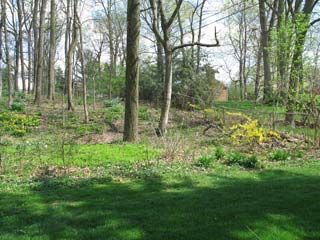 |
From the back corner at the bottom of the hill you can see forsythia that I planted as a bareroot whip, like the redbuds were. A green carpet of sweet woodruff spreads where the ground was dry and bare, and various wildflowers thrive here: a cluster of snowdrops, Jacob's ladder, bugleweed, bloodroot and some shoots of Jack-in-the-pulpit that I started from the seeds of my one-and-only JIP plant.
|
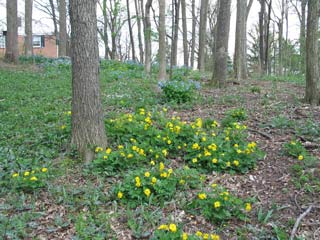 |
Celandine poppies are spreading through the lower section of the woods. I was warned they would be prolific, but I'm happy to have the ground cover. They don't seem to bother the other wildflowers so far; the waterleaf that has been there for years is still looking robuost. You can see a hint of the bluebells on the hillside. They have begun to spread to the lower woods in the past couple of years.
|
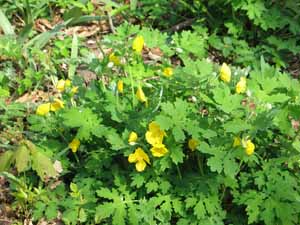 |  |
 |
Here you can see the bluebells on the crest of the hill. They look gorgeous at certain times of day when the light is just right. The groundcover coming down the hill is periwinkle, which I originally planted in a small area near the house where grass wouldn't grow. Purists warn against it in a woodland setting, but it works for me. It doesn't seem to bother the toothwort, either. Bluebells have begun to pop up in the middle of the mass of periwinkles.
|
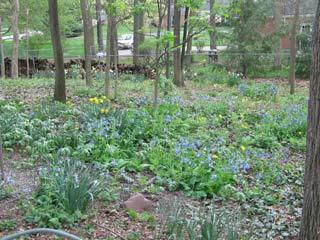 |
Looking across the woods from my patio you can see the original patch of bluebells in the foreground. I transplanted some from the edges of that group to different areas of the woods and discovered that they are self-seeding. They have begun to drift down the hillside. Here and there are white isopyrum and both yellow and red epimedium. At the back by the woodpile are some daffodils that put on a big show this spring, which was welcome after the blizzard in March.
|
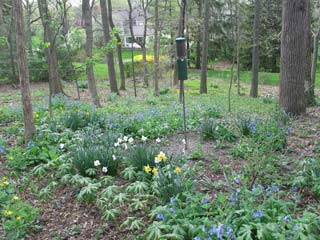 |
May-apples, bluebells and daffodils flourish here. My original Jack-in-the-pulpit is just beginning to push out of the ground in this area. There are also isopyrum, buttercup, wild ginger, spring beauty, and purple phlox. Not to mention blue, red, white and yellow violets. And wild geranium and shooting star that haven't bloomed yet. Sunflower shells from the bird feeder have prevented some of the bluebells from coming through this year.
|
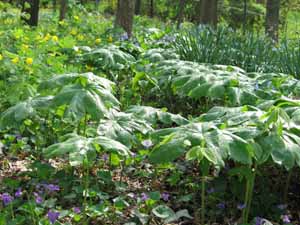 | 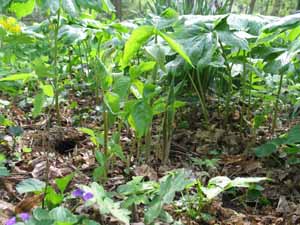 |
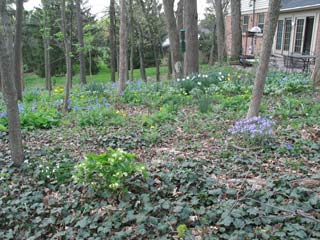 |
The white flowers on the left are isopyrum. In the center foreground you can see a hellebore. To the right is purple phlox. I made a natural path, outlined with fallen tree branches, that runs along the edge of the English ivy. The ivy grew from clippings that I tossed into the woods many years ago. I try to keep it confined to the edge of the woods, next to the fence at the top of the hill. In the back corner (not shown) there are six buckeye tree seedlings that are now about two-feet tall. |
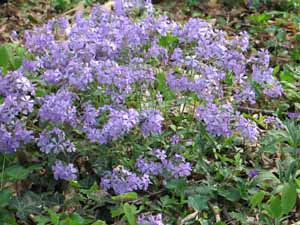 |
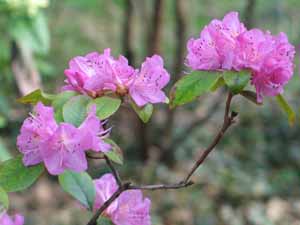
|
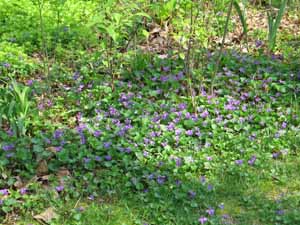 |
Blue violets like these can be pesky in a garden, but in the woods they are lovely. They are so prolific that I don't feel guilty thinning them out. In addition to the purple ones, there are several others I didn't plant. One has a lavender center on white. And there are small, yellow sweet-violets. I planted a white one with a red center and a red one. Another is white with purple stripes in the throat. Such variety! They all reseed themselves, but none as freely as these. I also planted one called "Freckles," a white with blue spots, but it disappeared. I have no idea why some plants make it and others either give up or go dormant for awhile.
|
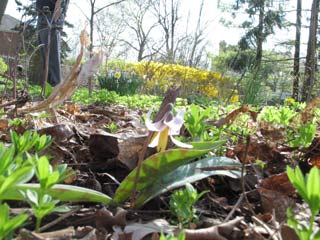 |
I planted four trout lilies the first spring after we cleared the honeysuckle. They never showed up and I forgot about them. Last year I came upon one leaf, so I watched for it this year and was rewarded with a single bloom. I was also surprised this year when three single bloodroot flowers I've watched every year spread into little colonies with up to eight blossoms on each. Another stubborn starter was Dutchman's breeches, which has spread into good-sized mounds where I planted them. One was an orphan that barely stayed alive for several years until I moved it.
|
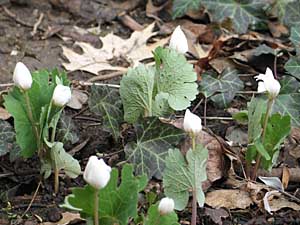
|
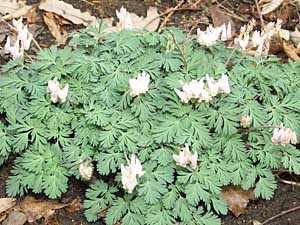 |
|
|
|
|
|
|
|
|
|
Wildflowers |
Home Return to Top
|


















